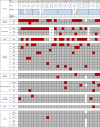Myeloid neoplasms with isolated isochromosome 17q demonstrate a high frequency of mutations in SETBP1, SRSF2, ASXL1 and NRAS
- PMID: 26883102
- PMCID: PMC4924712
- DOI: 10.18632/oncotarget.7350
Myeloid neoplasms with isolated isochromosome 17q demonstrate a high frequency of mutations in SETBP1, SRSF2, ASXL1 and NRAS
Abstract
Isolated isochromosome 17q, i(17q), accounts for less than 1% of myeloid neoplasms that are commonly classified as myelodysplastic/myeloproliferative neoplasms, acute myeloid leukemia (AML), myelodysplastic syndrome (MDS) or myeloproliferative neoplasms (MPN). We have shown previously that these cases have distinctive clinicopathologic features, a poor prognosis and absence of TP53 mutations. However, their molecular mutation profile has not been studied. Here, we explored the mutation profile of 32 cases of myeloid neoplasm with isolated i(17q) that included AML, MDS/MPN, MDS and MPN. In addition to the common i(17q), these neoplasms had frequent mutations in SRSF2 (55%), SETBP1 (59%), ASXL1 (55%), and NRAS (31%); TET2 and TP53 mutations were rare. Eight of 28 patients (29%) showed concurrent mutations in ASXL1, SRSF2, SETBP1 and RAS. There was a significant association between mutations in SETBP1 and RAS (p = 0.003). The mutation pattern was independent of the morphologic diagnosis. Sequential analysis of 5 cases showed evolution from a diploid karyotype to i(17q) and that SRSF2 and ASXL1 mutations precede the detection of i(17q) whereas SETBP1 mutations are associated with i(17q).
Keywords: ASXL1; SETBP1; SRSF2; isochromosome 17q; myeloid neoplasms.
Conflict of interest statement
The authors declare that they have no conflicts of interest.
Figures


Similar articles
-
Somatic SETBP1 mutations in myeloid neoplasms.Int J Hematol. 2017 Jun;105(6):732-742. doi: 10.1007/s12185-017-2241-1. Epub 2017 Apr 26. Int J Hematol. 2017. PMID: 28447248 Review.
-
SETBP1 mutations occur in 9% of MDS/MPN and in 4% of MPN cases and are strongly associated with atypical CML, monosomy 7, isochromosome i(17)(q10), ASXL1 and CBL mutations.Leukemia. 2013 Sep;27(9):1852-60. doi: 10.1038/leu.2013.133. Epub 2013 Apr 30. Leukemia. 2013. PMID: 23628959
-
Myeloid neoplasms with isolated isochromosome 17q represent a clinicopathologic entity associated with myelodysplastic/myeloproliferative features, a high risk of leukemic transformation, and wild-type TP53.Cancer. 2012 Jun 1;118(11):2879-88. doi: 10.1002/cncr.26537. Epub 2011 Oct 28. Cancer. 2012. PMID: 22038701
-
Genomic Landscape of Myelodysplastic/Myeloproliferative Neoplasms: A Multi-Central Study.Int J Mol Sci. 2024 Sep 23;25(18):10214. doi: 10.3390/ijms251810214. Int J Mol Sci. 2024. PMID: 39337700 Free PMC article.
-
Mutations in chronic myelomonocytic leukemia and their prognostic relevance.Clin Transl Oncol. 2021 Sep;23(9):1731-1742. doi: 10.1007/s12094-021-02585-x. Epub 2021 Apr 16. Clin Transl Oncol. 2021. PMID: 33861431 Review.
Cited by
-
Myelodysplastic/myeloproliferative neoplasms-unclassifiable with isolated isochromosome 17q represents a distinct clinico-biologic subset: a multi-institutional collaborative study from the Bone Marrow Pathology Group.Mod Pathol. 2022 Apr;35(4):470-479. doi: 10.1038/s41379-021-00961-0. Epub 2021 Nov 13. Mod Pathol. 2022. PMID: 34775472 Free PMC article.
-
Somatic SETBP1 mutations in myeloid neoplasms.Int J Hematol. 2017 Jun;105(6):732-742. doi: 10.1007/s12185-017-2241-1. Epub 2017 Apr 26. Int J Hematol. 2017. PMID: 28447248 Review.
-
Concomitant isochromosome 17q and mutated SETBP1 in a myelodysplastic syndrome patient with a poor prognosis.Int J Clin Exp Pathol. 2017 Sep 1;10(9):9786-9792. eCollection 2017. Int J Clin Exp Pathol. 2017. PMID: 31966863 Free PMC article.
-
Bone marrow pathologic abnormalities in familial platelet disorder with propensity for myeloid malignancy and germline RUNX1 mutation.Haematologica. 2017 Oct;102(10):1661-1670. doi: 10.3324/haematol.2017.167726. Epub 2017 Jun 28. Haematologica. 2017. PMID: 28659335 Free PMC article.
-
Only SF3B1 mutation involving K700E independently predicts overall survival in myelodysplastic syndromes.Cancer. 2021 Oct 1;127(19):3552-3565. doi: 10.1002/cncr.33745. Epub 2021 Jun 23. Cancer. 2021. PMID: 34161603 Free PMC article.
References
-
- Kanagal-Shamanna R, Bueso-Ramos CE, Barkoh B, Lu G, Wang S, Garcia-Manero G, Vadhan-Raj S, Hoehn D, Medeiros LJ, Yin CC. Myeloid neoplasms with isolated isochromosome 17q represent a clinicopathologic entity associated with myelodysplastic/myeloproliferative features, a high risk of leukemic transformation, and wild-type TP53. Cancer. 2012;118:2879–2888. - PubMed
-
- McClure RF, Dewald GW, Hoyer JD, Hanson CA. Isolated isochromosome 17q: a distinct type of mixed myeloproliferative disorder/myelodysplastic syndrome with an aggressive clinical course. Br J Haematol. 1999;106:445–454. - PubMed
-
- Visconte V, Tabarroki A, Zhang L, Hasrouni E, Gerace C, Frum R, Ai J, Advani AS, Duong HK, Kalaycio M, Saunthararajah Y, Sekeres MA, His ED, et al. Clinicopathologic and molecular characterization of myeloid neoplasms harboring isochromosome 17(q10) Am J Haematol. 2014;89:862. - PubMed
-
- Schanz J, Tuchler H, Sole F, Mallo M, Luno E, Cervera J, Granada I, Hildebrandt B, Slovak ML, Ohyashiki K, Steidl C, Fonatsch C, Pfeilstocker M, et al. New comprehensive cytogenetic scoring system for primary myelodysplastic syndromes (MDS) and oligoblastic acute myeloid leukemia after MDS derived from an international database merge. J Clin Oncol. 2012;30:820–829. - PMC - PubMed
-
- Sánchez-Castro J, Marco-Betés V, Gómez-Arbonés X, Arenillas L, Valcarcel D, Vallespí T, Costa D, Nomdedeu B, Jimenez MJ, Granada I. Characterization and prognostic implication of 17 chromosome abnormalities in myelodysplastic syndrome. Leuk Res. 2013;37:769–776. - PubMed
MeSH terms
Substances
Grants and funding
LinkOut - more resources
Full Text Sources
Other Literature Sources
Medical
Research Materials
Miscellaneous

